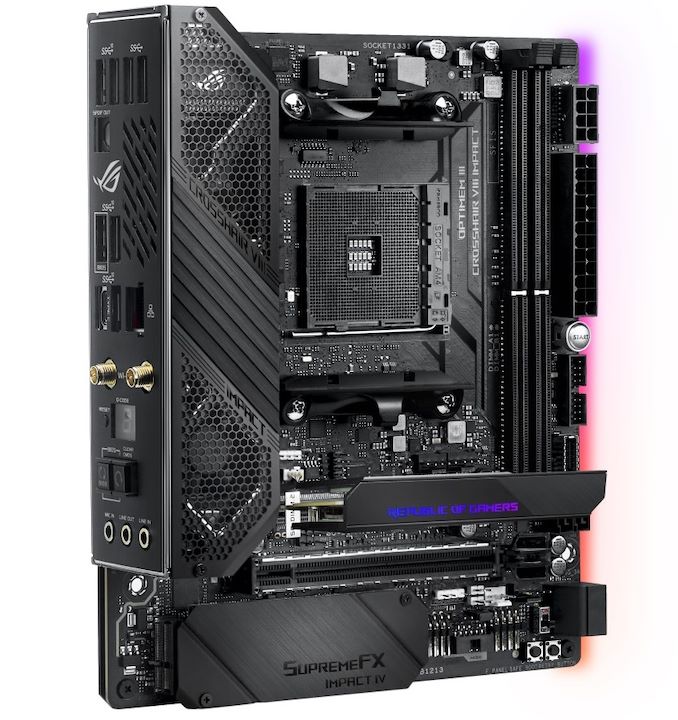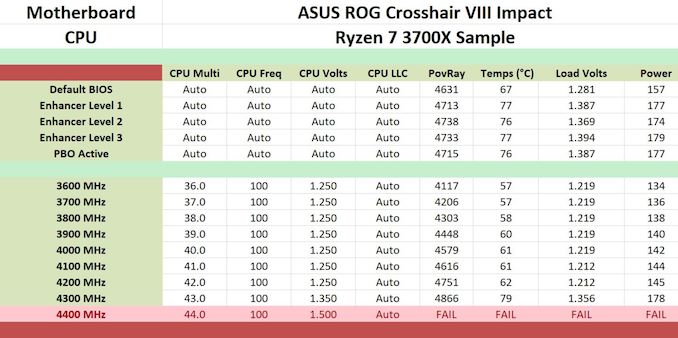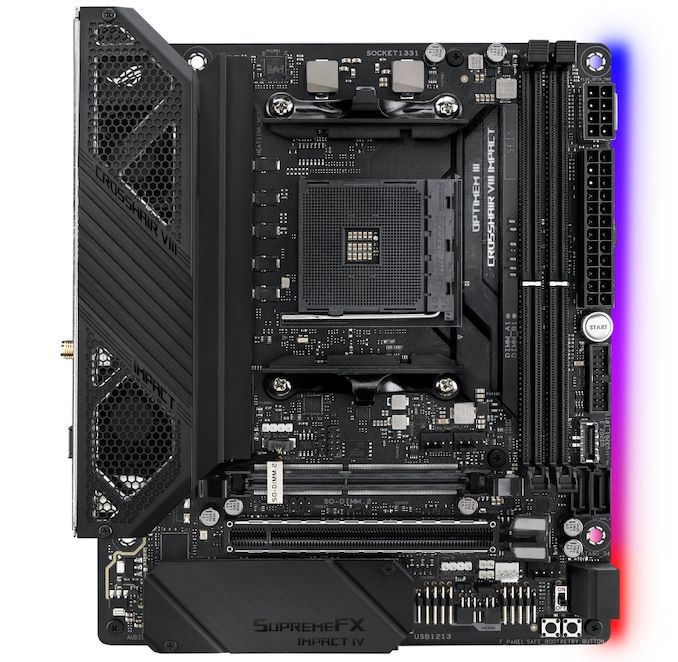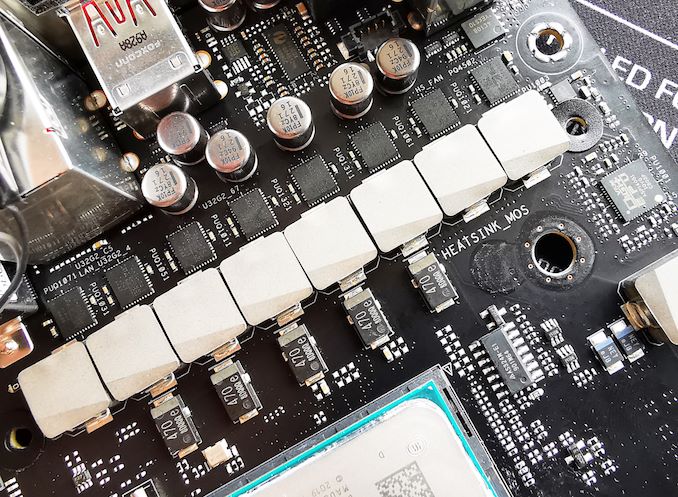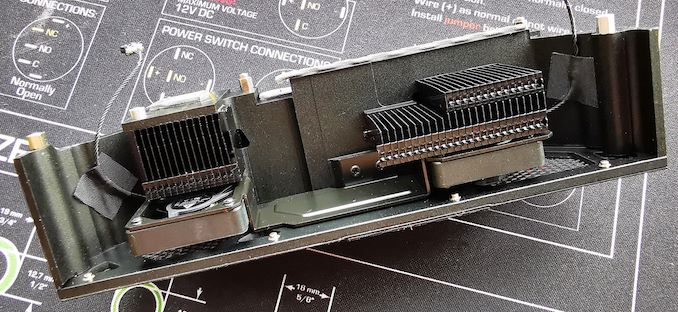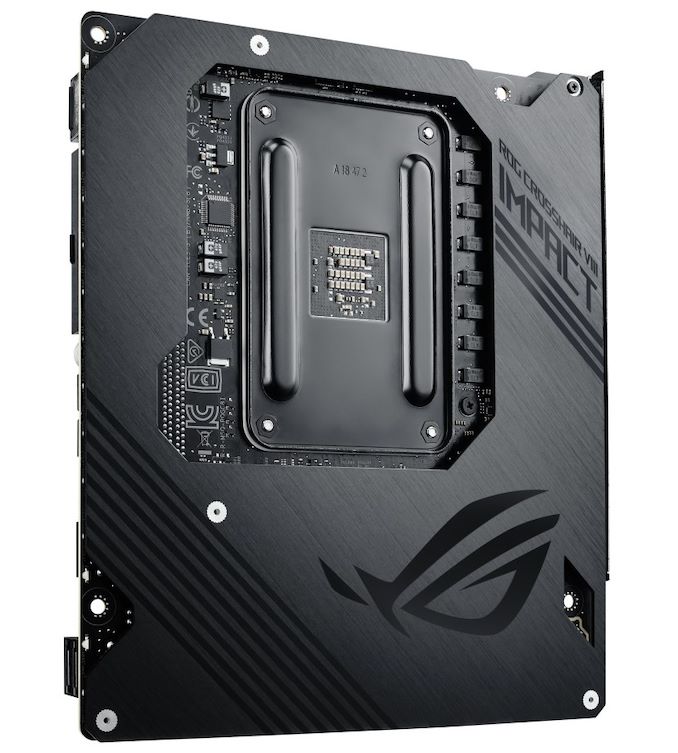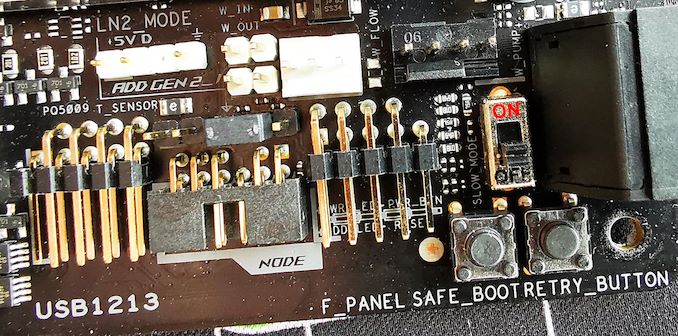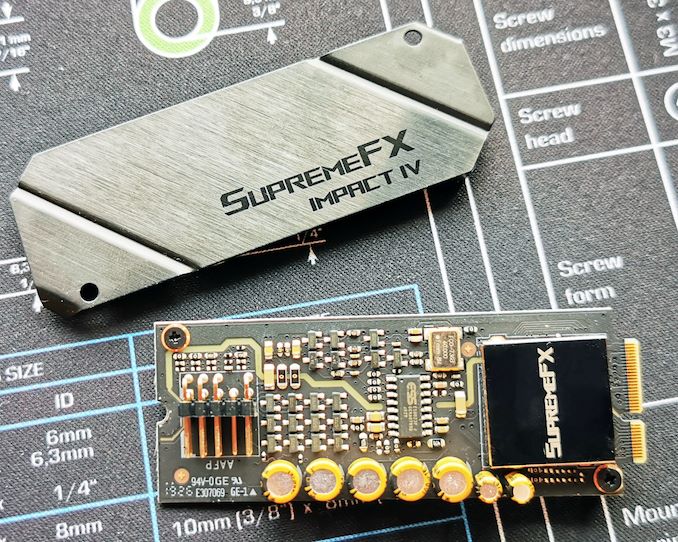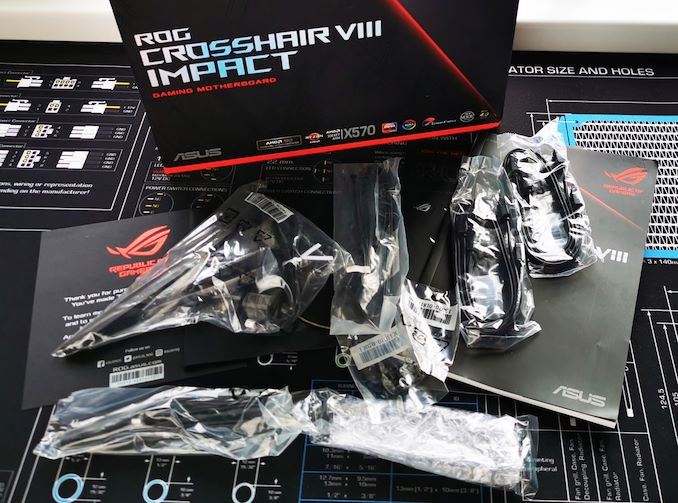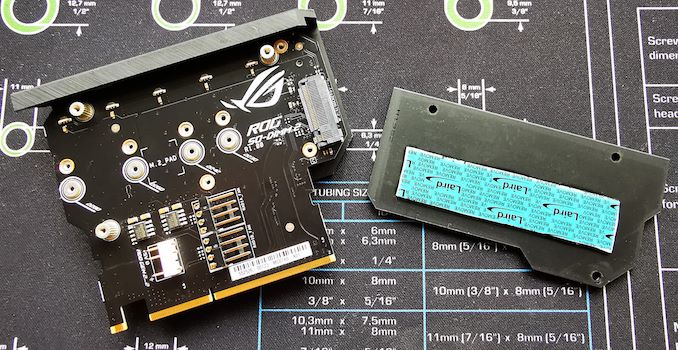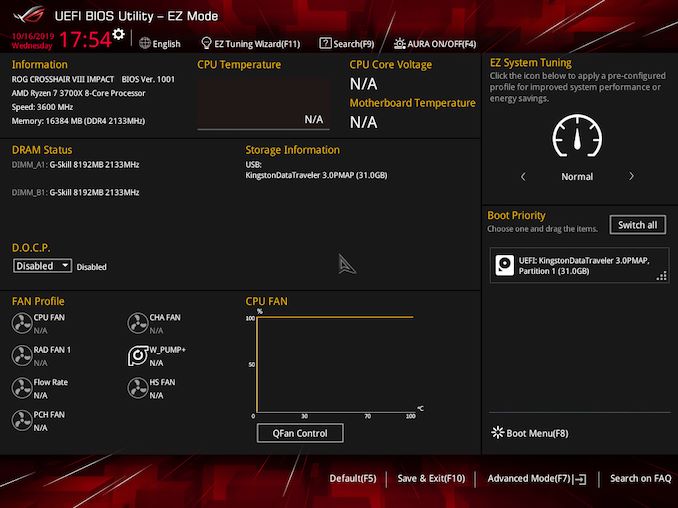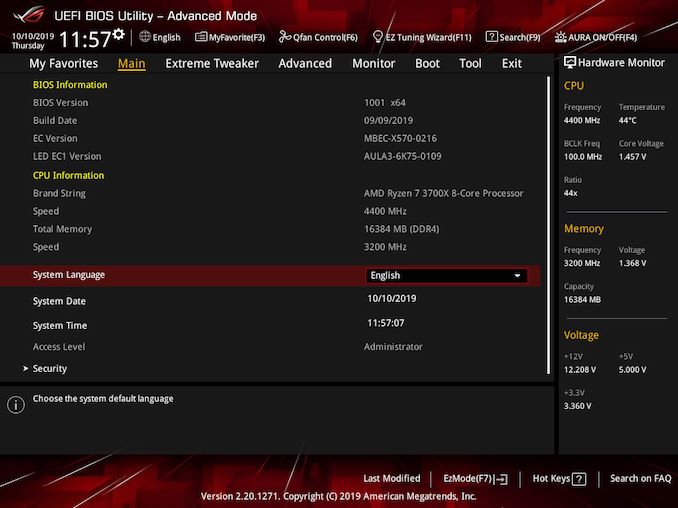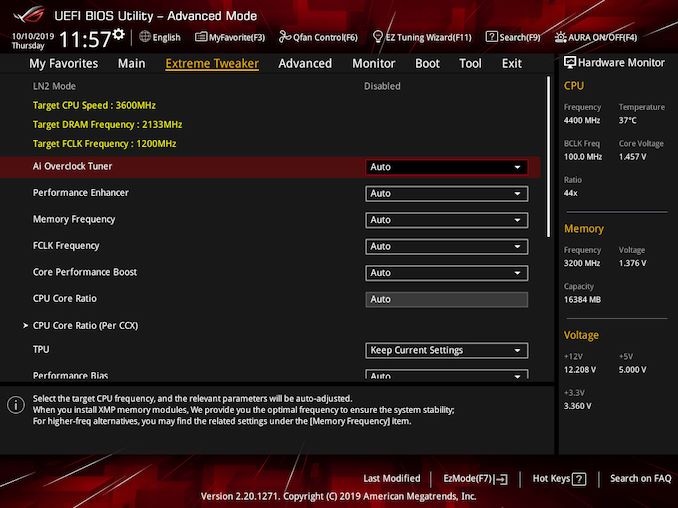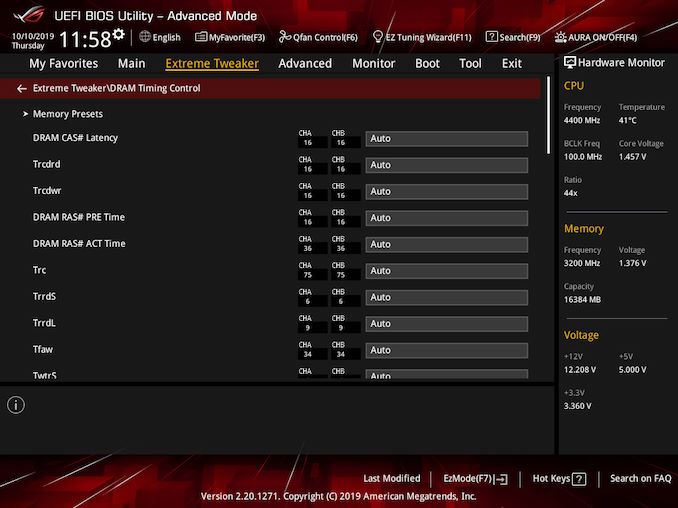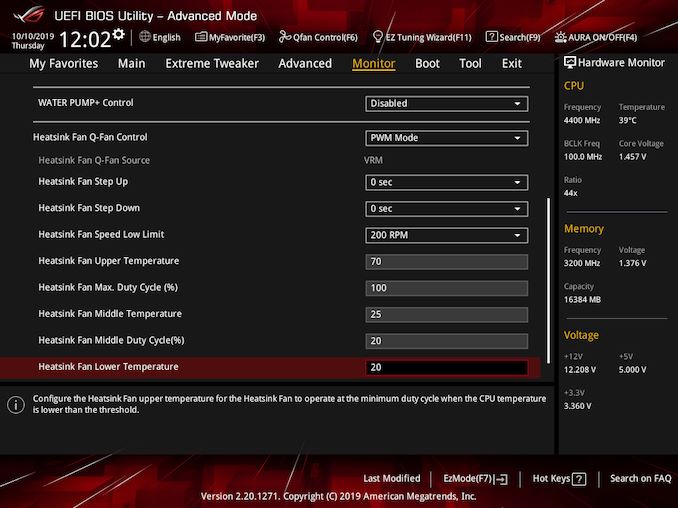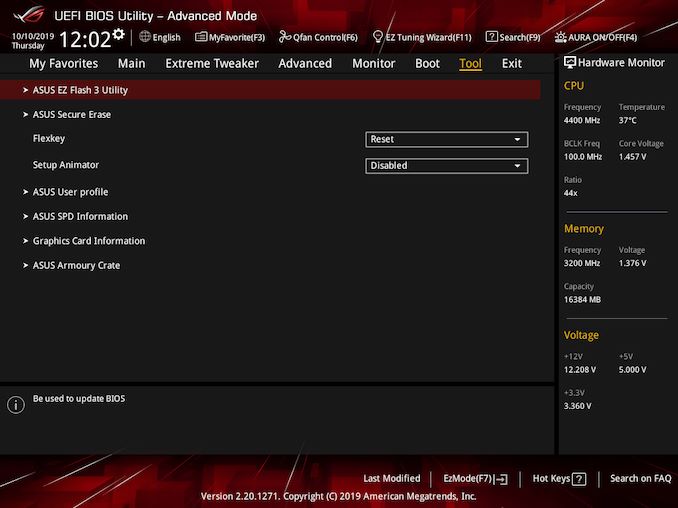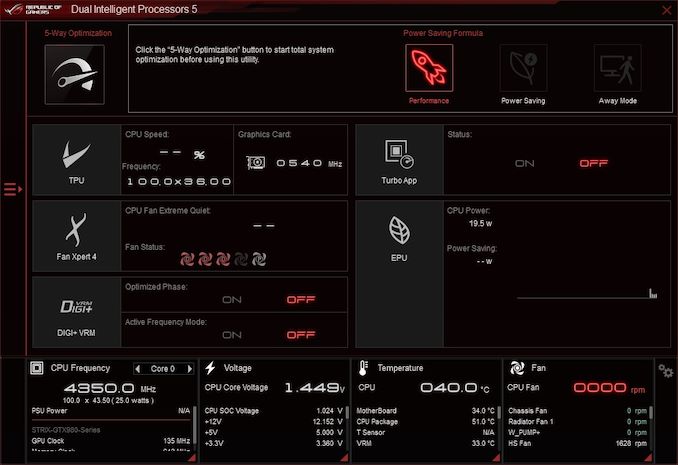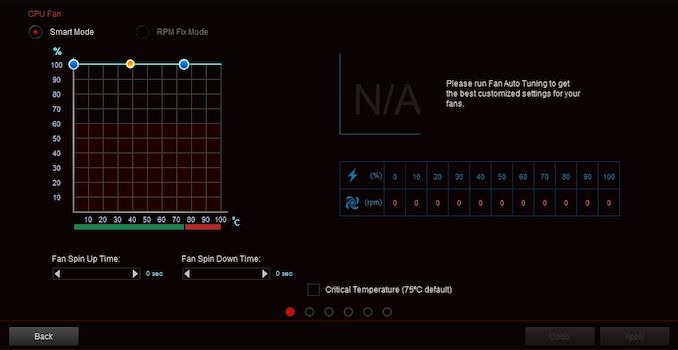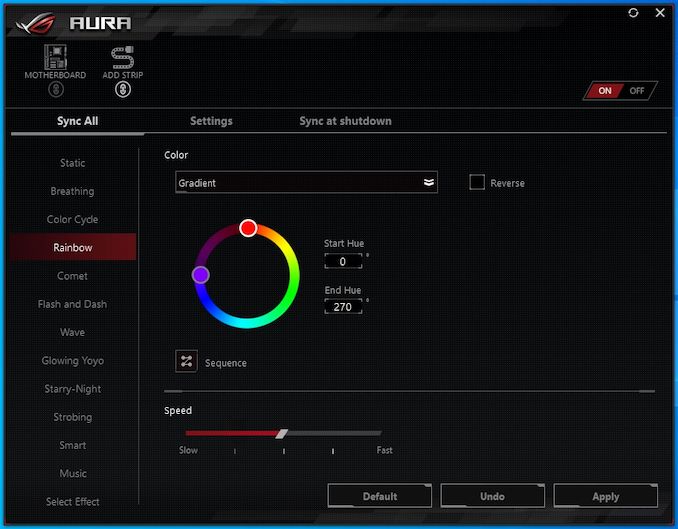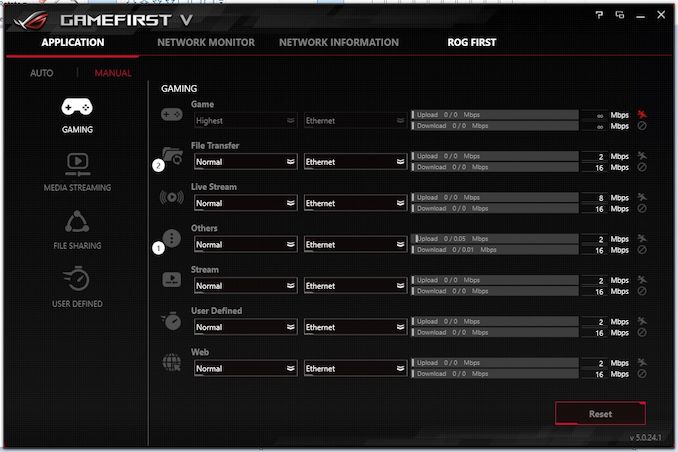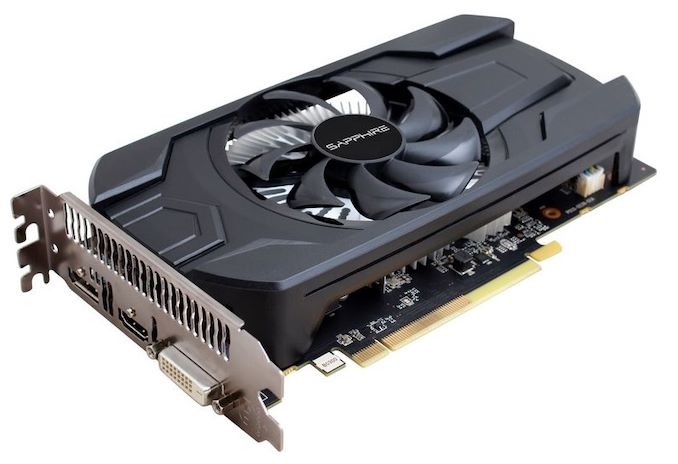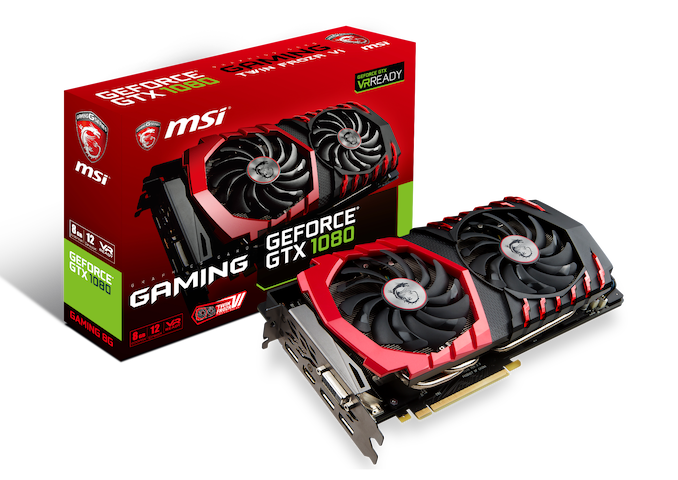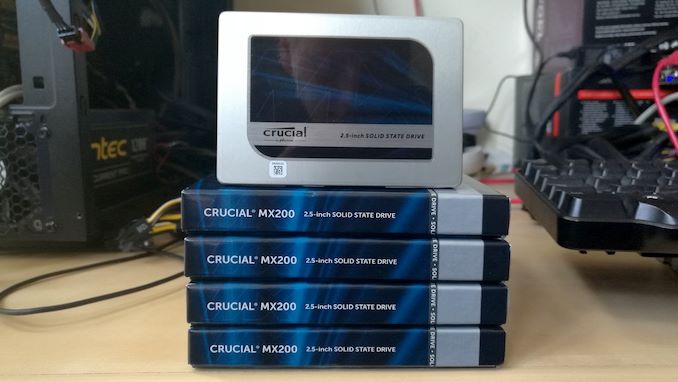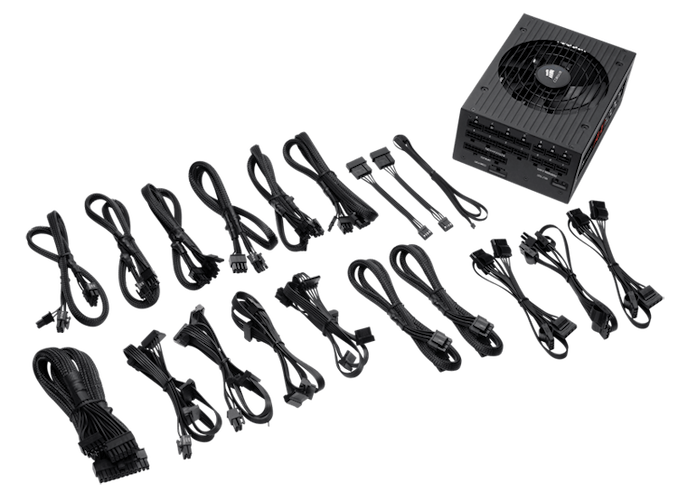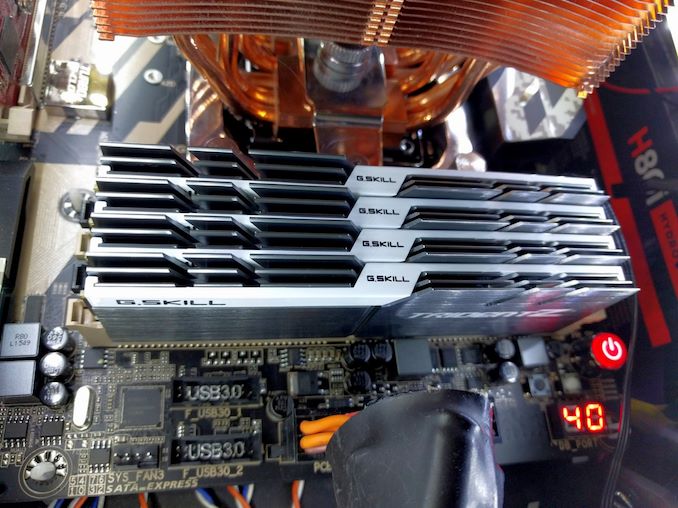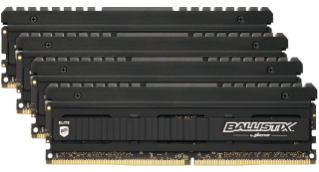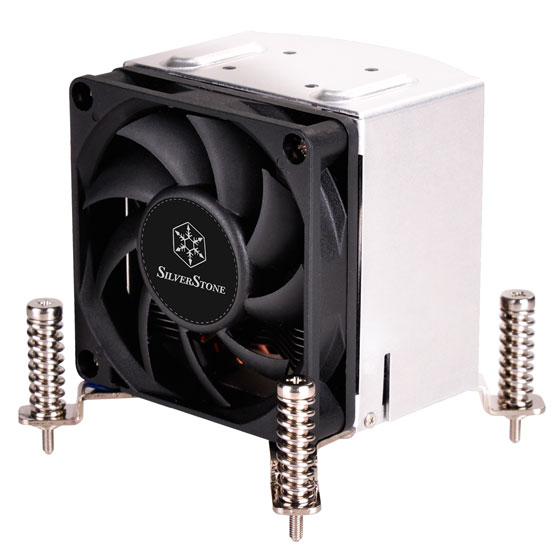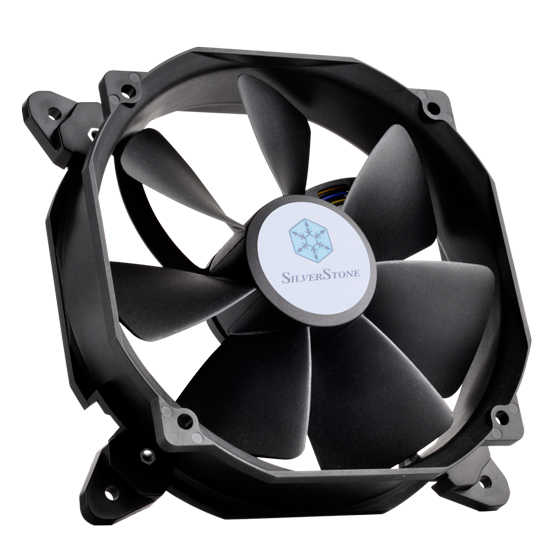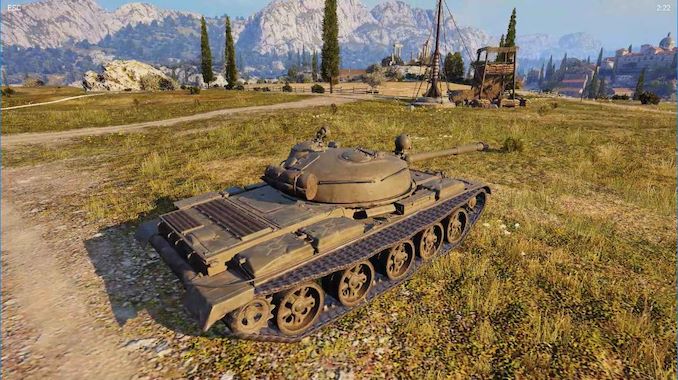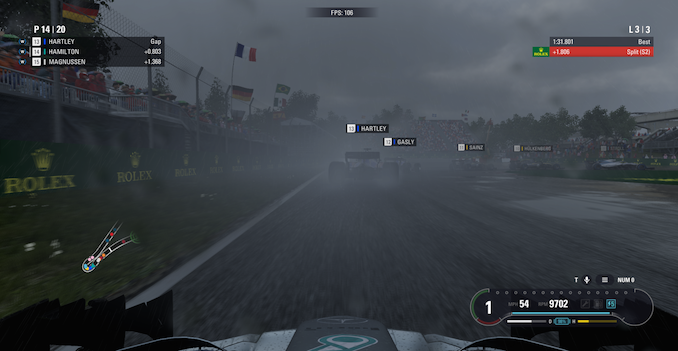
Original Link: https://www.anandtech.com/show/14950/the-asus-rog-crosshair-viii-review
The ASUS ROG Crosshair VIII Impact: A Sharp $430 Impulse on X570
by Gavin Bonshor on October 25, 2019 11:30 AM EST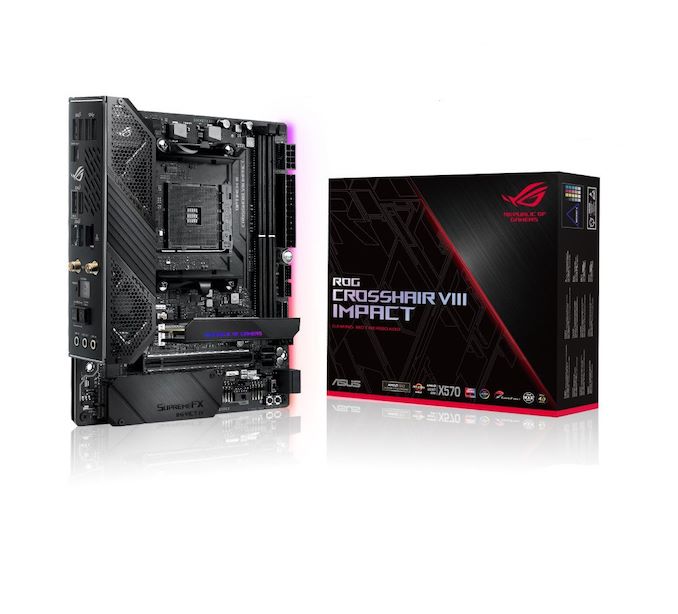
One of the most interesting unveilings from the X570 launch earlier this year came from ASUS, with the reintroduction of the ROG Impact series of small form factor motherboards. Not seen since the days of Intel Z170 days, the ASUS ROG Crosshair VIII Impact is the first truly AMD high-end SFF model from the vendor. Accompanied by its SO-DIMM.2 slot for dual PCIe 4.0 x4 M.2 SSDs, a SupremeFX S1220 HD audio codec and support for up to DDR4-4800 memory, the Impact looks to leave its mark on AM4 for enthusiasts just like previous iterations have done on Intel platforms. The only difference this time round is that it's not a true Mini-ITX like the previous Impact designs.
What Is Mini-DTX?
When ASUS unveiled the ROG Crosshair VIII Impact, a lot of users were somewhat confused as to why the manufacturer adopted the unconventional mini-DTX form factor over the more commonly used mini-ITX. One of the primary caveats with small form factors such as mini-ITX is space. The bigger the standard, the more of an advantage features like space for an extra expansion slot can be taken advantage of - it could be the difference between two PCIe 4.0 x4 M.2 slots and none.
In order to best use this space, ASUS has (among other things) included it's special dual M.2 riser module, known as a SO-DIMM.2 slot. This is a way to add dual M.2 slots with a vertical mount to save additional PCB space. It's not the first time it's been done - other high-end models from its line-up including the ASUS ROG Maximus X Apex uses the same technology.
There is also a PCIe 4.0 x4 M.2 slot at the bottom, underneath the full-length PCIe 4.0 x16 slot, but this is populated with a SupremeFX S1220A HD audio codec and ESS ES9023P DAC mounted onto an M.2 add-in card. This saves some PCB space and effectively makes the audio a more modular component.
The ASUS ROG Crosshair VIII Impact also has a single Intel I211-AT Gigabit Ethernet controller as well as an Intel AX200 Wi-Fi 6 wireless interface which provides Wi-Fi and BT 5.0 connectivity. While the board does allow users to use up to two PCIe 4.0 x4 M.2 drives via the SO-DIMM.2 slot, there are also four SATA ports which support RAID 0, 1, and 10 arrays. The slightly larger ROG Crosshair VIII Impact uses the traditional AM4 cooler mounts with a cleaner socket area with not just compatibility with the full range of AM4 coolers, but allows for enthusiasts to install the best cooling in the business without fanfare.
Equipped with a 10-phase power delivery which is running with eight teamed TDA21472 70 A power stages for the CPU are a particular highlight and one that helps justify its enthusiast-level market price of $430. The ASP1405I is an 8-channel PWM controller and is operating in 4+2 mode. The other factor to consider is thermal performance and the Crosshair VIII Impact is using a heatsink across the CPU power delivery section, with a 30 mm cooling fan directing airflow to aid in cooling; there is a second 30 mm fan which is directed over the X570 chipset.
Another enthusiast-level feature is support for DDR4-4800 memory which two slots allowing for users to install up to 64 GB of system memory, as well as supporting the DC double height and double capacity UDIMMs that ASUS supports on its two slot Intel Z390 models.
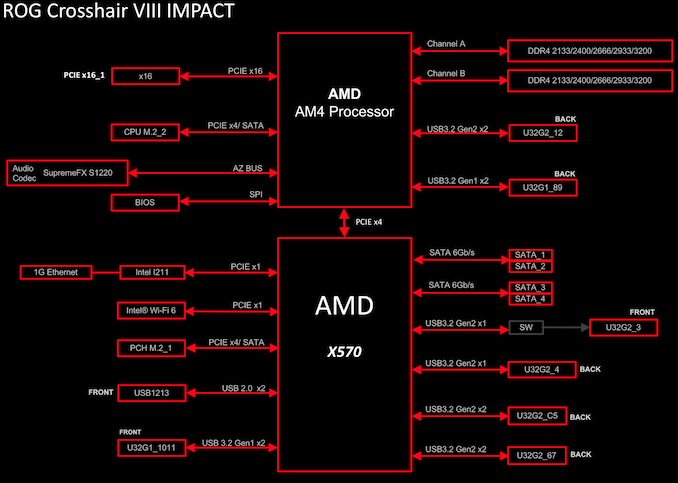
ASUS ROG Crosshair VIII Impact Block Diagram
Looking at the performance of the ASUS ROG Crosshair VIII Impact in our test suite and it displays a strong and stable showing. In our system-specific tests, the Crosshair VIII Impact posted some of the fastest POST times we have seen from an X570 model, as well as solid results in our power consumption tests. In our computational tests, the X570 Impact also competed well with other models on test with the best performance coming in our 3DPM test; the new highest performer from all X570 models tested. This smaller mini-DTX creation has the equipment to take on its larger flagship counterparts.
One of the biggest aspects to consider when manually overclocking with the ASUS ROG Crosshair VIII Impact is the level of VDroop when the LLC setting is set to automatic. Applying 1.250 V on the CPU VCore between 3.6 and 4.2 GHz on our Ryzen 7 3700X equated to between 1.212 V and 1.219 V at load which is around 0.038 V of VDroop. Moving up to 4.3 GHz which required a CPU VCore value of 1.350 V in the BIOS ran with a load CPU VCore of 1.356 V which was overcompensated by the firmware by just 0.006 V; quite tight and expected given the boards focus for enthusiasts and extreme overclockers. There is an LN2 mode jumper which will bypass certain AMD restrictions for users looking to push silicon to its hard limits, but this should be left well alone for users on ambient cooling. The Precision Boost Overdrive can be enabled but to little effect compared to the default settings with a slight improvement, but the three levels of PBO enhancement proved to be similar in performance with different levels, albeit minimal levels of CPU VCore voltage observed.
As it stands, the ASUS ROG Crosshair VIII Impact is in a product segment of its own. It is the only mini-DTX model in existence in the desktop segment, and we can either compare it to smaller boards or slightly larger boards. Users can make similarities in other small form factor models including the ASUS ROG Strix X570-I Gaming ($299), the recently reviewed ASRock X570 Phantom Gaming-ITX/TB3 ($240) which did impress us, and the GIGABYTE X570 I Aorus Pro WIFI ($220) which at present, is the cheapest small form factor X570 model available on the market. The ASUS ROG Crosshair VIII Impact has a list price of $430 at Newegg and is nearly double the cost of GIGABYTE's mini-ITX model; the Impact is targeted at a much more specific enthusiast level market than the other models with performance and enhanced componentry which further bolsters its high price tag.
Read on for our extended analysis.
Visual Inspection
The ASUS ROG Crosshair VIII Impact is a mini-DTX motherboard which retails for $430 and represents the high-end small form factor X570 market. What it lacks in size, it makes up for in some very creative and interesting space-saving methods to include some of its core features. Around the sides of the AM4 CPU socket is a stacked PCB with plenty of well-utilized space. This coupled with a sleek all-black design across the rear panel cover, heatsinks, and the PCB make this a very color neutral looking board. There are some integrated RGB LEDs on the right-hand side of the board which isn't as extensive as some other ASUS ROG models of late, but the subtly is actually a strong point in terms of aesthetics.
Using the mini-DTX form factor over mini-ITX has allowed ASUS to feature its SO-DIMM.2 slot abouve the main PCIe slot. This allows users to install up to 2 x PCIe 4.0 x4 M.2 drives in a handy compact shell which does incorporate a heatsink for each drive on either side of the card. Further to the M.2 is four SATA ports with two right-angled, and two straight-angled ports which support RAID 0, 1, and 10 arrays. Below the SO-DIMM.2 slot is a full-length PCIe 4.0 x16 slot, with both slots being lathered in a metal coating to reinforce and protect the slots from physical damage. Along the bottom of the PCB are a right-angled USB 2.0 header, a right-angled front panel header, and a small overclockers toolkit which is located in the bottom right-hand corner.
Memory support on the ROG Crosshair VIII Impact is impressive with support for DDR4-4800 out of the box and has support for up to 64 GB across the two available slots. Motherboards with two memory slots are commonly used by overclockers to push memory clock speeds with tighter timings with shorter traces which can enhance memory speeds. This is one of the main reasons extreme overclockers tend to favour models with two memory slots such as the ASUS ROG Maximus X Apex, and previous versions of the Impact series. A total of three 4-pin fan headers are present with one set aside for a CPU fan, one for a water pump, and another for a chassis fan; the ROG SO-DIMM.2 integrates a further two 4-pin fan headers onto it so it does provide more functionality. It also has an addressable RGB header which complements the single addressable RGB header located on the PCB
The power delivery on the ASUS ROG Crosshair VIII Impact is using a 10-phase configuration with an ASP1405I which is a rebranded Infineon IR35201 PWM controller. This controller operates in 4+2 mode, which would normally mean we expect to see doublers in play. But for the Impact series, ASUS is doing something very clever - they are able to double the phase count without using additional hardware by teaming the phases. There are tradeoffs with this design, as it requires initial high frequency signal duplication from the controller rather than splitting a signal with a doubler, and ASUS believes if gives them both an operational advantage and a cost advantage. (Note, this is different to just doubling components in series, ASUS does have a true parallel phase design in play).
For power delivery, The CPU section is using eight Infineon TDA21472 70 A power stages which are teamed for better transient response and improved efficiency. Each power stage is accompanied by an inductor and has its own aluminium polymer capacitor on the rear of the board with a further four located on the front side of the PCB.
The eight power stages are cooled by a well-built aluminium heatsink which is assisted by a 30 mm fan integrated into the rear panel cover; one 30 mm fan is directly focused onto the power delivery and one on the X570 chipset. This is incorporated into the design of the rear panel cover and comes off the board in a single piece. It's a clever way of maximising the lack of space available.
On the rear of the PCB is a metal backplate which incorporates a heatsink which covers the rear-mounted SoC power delivery. In a slight design twist, the SoC section consists of two Infineon TDA21472 70 A power stages are actually located on the rear of the PCB. These are operating individually and makes the Crosshair VIII Impact's power delivery a +2 design. The heat pipe built into the backplate isn't just cooling the SoC section, but it also covers the rear of the 8-phase CPU area for better thermal performance; something a lot of vendors don't cater for on its enthusiast-level models.
On the side of the board is the 'overclocker's toolkit'. This toolkit is designed for extreme overclockers and enthusiasts looking to push the envelope of the Ryzen 3000 processors with sub-ambient cooling methods such as liquid nitrogen and dry ice. Users looking to bypass certain AMD power and voltage restrictions can use the LN2 mode via the jumper, but this is not recommended unless you are proficient and plan to do some serious overclocking. Misuse of this can severely damage componentry and will instantly void the warranty. A small safe boot switch allows extreme users to automatically force the system to enter into safe mode which can be handy for failed overclocks and helping to resolve POST issues. The OC Retry switch is similar to the safe boot button but instead lets users retry failed overclockers which hang during the POST phase and can be very handy for quicker memory training when doing memory overclocking. Above the switches is a slow mode dip switch which allows users to have an element of control over clock speeds which can allow systems to start off at minimum clock speeds, and then re-apply them when the system has gone through stressful stages of POST which can sometimes crash when clock speeds are too intense for the system to handle.
ASUS has decided to opt for a different approach to its implementation of the onboard audio on the ROG Crosshair VIII Impact with its audio componentry on an M.2 card which slots into the only onboard M.2 B-key slot located just below the full-length PCIe 4.0 x16 slot. This add-on card isn't designed to be removed and is an ingenious way of saving some space while isolating the audio PCB from the rest of the board's internal componentry. The M.2 audio card includes a SupremeFX S1220 HD audio codec with an EMI shield, an ESS ES9023P DAC, a front panel audio header, and has seven gold Japanese audio capacitors. It is covered up with a subtle black ROG themed metal fascia so that the audio PCB is hidden from sight, and is one of the most unique ways we've seen to implement onboard audio.
The Impact has one of the most equipped rear panels for USB connectivity compared with other small form factor models on X570 with five USB 3.1 G2 Type-A, a single USB 3.1 G2 Type-C, and two USB 3.1 G1 Type-A ports. There are two antenna ports for the Intel AX200 Wi-Fi 6 802.11ax wireless interface, while the single Ethernet port is controlled by an Intel I211-AT Gigabit controller. Also featured is a reset CMOS switch, a Q-Code LED debug, and a USB BIOS Flashback button. A SupremeFX S1220 HD 8-channel audio codec powers three 3.5 mm audio jacks and S/PDIF optical output is assisted by an ESS ES9023P HD DAC.
What's in the Box
Included in the accessories bundle of the ROG Crosshair VIII Impact are four SATA cables, a user manual, two M.2 screw kits, the ROG SO-DIMM.2, an Intel AX200 wireless antenna, a ROG panel cable, and a chipset driver installation disc. There are also some non-hardware specific items included such as a ROG branded coaster, a ROG thank you card and a large ROG sticker sheet.
Nestled in the accessories bundle is the ROG SO-DIMM.2 which has slots with support for M.2 2280 PCIe 4.0 x4 and SATA drives; one on either side of the module. Each side has its own individual heatsink. Due to the design and how tall the SO-DIMM.2 is when installed, it should theoretically benefit from chassis with good passive airflow. Also included on the SO-DIMM.2 is two 4-pin fan headers and an extra addressable RGB LED connector. At every turn, ASUS is making use of space where it can.
- User manual
- Chipset driver support CD
- 4 x SATA cables
- 2 x M.2 screw kits
- Large ROG sticker sheet
- Intel AX200 Wi-Fi antenna
- RGB extension cable
- ARGB extension cable
- ROG panel cable
- ROG coaster
- ROG thank you card
- ROG SO-DIMM.2 module
BIOS
The ASUS ROG firmware is very consistent throughout its range which is good for brand awareness with its red and dark grey theme, with white test and deep red highlighting when hovering over each setting. There are two different modes to select from; an EZ (easy) mode for users looking to make basic changes, and an advanced mode which opens up a wealth of settings and options for overclocking.
The EZ mode is very easy to navigate with plenty of basic functions which include allowing users to apply X.M.P memory profiles, something ASUS calls D.O.C.P. Users can also alter the boot priority and access the Q-Fan control settings, as well as see basic information about the processor, the firmware version, and fan speed information. The information on the memory is very basic with the brand, capacity, and basic SPD profile speed of the installed memory.
Pressing F7 key within the firmware allows users to switch between the Ez and advanced modes. Entering the advanced mode opens up on the main menu. The main panel displays a basic overview of information relating to the firmware version installed, the processor that's installed, and allows users to change the firmware language, the system date, time, and make security setting changes. It also opens up the extreme tweaker, advanced, monitor, boot, tool, and exit menus.
Moving to the extreme tweaker section, this is where all of the CPU and memory overclocking tools and settings are housed. Despite there being no actual overclocking presets to select from, users can use the Ai Overclock tuner to enable X.M.P memory profiles, or enter manual mode to customize both memory, and CPU frequency settings. Further down the extreme tweaker section is plenty of voltage control options for the CPU, memory, and things like SoC voltage, SB and PLL voltages. The performance enhancer setting allows users to select between three different levels of Precision Boost Overdrive which we have tested within the overclocking section of this review.
Below is a list of limitations when using the current firmware for settings such as CPU VCore, CPU frequency, DRAM frequency, and the Infinity Fabric/FCLK frequency. It should be noted that most of these maximum values won't even be able to be reached, even with extreme cooling methods:
- Maximum CPU Frequency = 6.375 GHz
- Maximum CPU VCore = 1.7 V
- Maximum DRAM Frequency = DDR4-6000
- Maximum Infinity Fabric/FCLK Frequency = 3000 MHz
Note - We didn't enable LN2 mode at any point during our testing as we didn't want to risk potential damage to our testbed hardware.
The ASUS ROG Crosshair VIII Impact also has a wide variety of memory settings as expected, with customizable settings for primary, secondary, tertiary, and voltage settings. ASUS has even included a few high-performance memory presets for overclockers looking to run quick memory profiles as a base to work from.
Within the hardware monitor which is quite comprehensive in terms of displaying temperatures, fan speeds, and the values from the water-cooling thermal probes on the board, the Q-Fan configurator allows users to create their own fan profiles. Users can set values based on fan limit fan speeds, as well as fan ramp up/downtimes. Not only are the 4-pin fans customizable, but the firmware allows users to control the two small 30mm fans integrated into the rear panel cover.
The tool menu opens up a variety of utilities including the ASUS EZ Flash 3 utility for upgrading the board's firmware. Other tools such as the ASUS SPD information allow users to check the official SPD profiles from memory, the graphics card information lists basic information about the installed GPU, and users can enable or disable the integrated ASUS Armoury Crate which includes the board's drivers and software.
Overall the ASUS ROG firmware is functional, responsive, and user-friendly with plenty of overclocking, power, and X570 chipset related settings for users to sink their teeth into. The most important aspect of firmware is in its stability and the ASUS ROG firmware is just that, strong and stable, with a plethora of features and functions.
Software
The Armoury Crate is a small pool of integrated storage where users can install drivers and software within Windows; this is promoted during a fresh Windows 10 installation due to a setting in the BIOS (this can be disabled). Users have the option to utilize the Armoury Crate or download and install the latest updates directly from the official product page, but the ASUS armoury crate does save time. The most notable software included with ROG Crosshair VIII Impact software bundle is the AI Suite 3 overclocking and power utility, the ROG Aura RGB LED utility and the ROG Gamefirst V networking utility.
The ASUS AI Suite 3 software offers a host of different functions including access to the Dual Intelligent Processors 5 utility which allows users to optimize system performance. This amalgamates the TPU, Fan Xpert 4, and DIGI+ VRM menus into one easy place where users can one-click optimize all the settings based on the hardware installed, and basic parameters such as temperature and clock speed. Users can also apply three different power saving profiles which are performance, power saving, and away mode.
ASUS has a very 'in your face' way of saying that it has automatic optimization functions and in the Fan Xpert section of the AI Suite 3 software, the right-hand side of the screen makes this clear. There are options to select between the smart mode and RPM fix mode, as well as the ability to customize the fan curves and fan spin times. Users can also enable the Critical Temperature checkbox which is set to 75°C by default; this is quite low given how hot Ryzen 3000 processors run when even mildly overclocked all-cores.
Simple, yet effective, the ASUS ROG Aura RGB software allows users to customize the RGB LED strip on the underside of the PCB at the right-hand side. Users can select between twelve different LED lighting profiles ranging from Color Cycle to Starry-Night, and sync settings between the integrated RGB LEDs and the two ARGB LED headers.
The ASUS Gamefirst V software is essentially its version of a networking traffic shaping utility which allows users to assign different applications priority based on how important it is. This is designed to provide a faster and more immersive experience when online gaming, which also logs bandwidth used and allows users to make quick-fire adjustments.
Overall the software package supplied is useful to users looking to make changes to settings within Windows, but with the exception of the ROG Aura and GameFirst V applications, all of these power and optimizations can be done within the firmware. As we have experienced on ALL of the X570 models tested so far, users looking for an immersive and enhanced audio experience will need to search and download Sonic Studio III from the internet, as the software itself isn't downloadable directly from the official product page.
Board Features
The ASUS ROG Crosshair VIII Impact is one of two small form factor motherboards from ASUS and is the bigger of the pair with its slightly larger than normal PCB. Using the mini-DTX form factor allows ASUS to feature its ROG SO-DIMM.2 slot which allows users to install two PCIe 4.0 x4 M.2 drives with cooling support provided by the inclusive heatsink. Other storage options include four SATA ports with support for RAID 0, 1, and 10 arrays. The Impact features an Intel I211-AT Gigabit ethernet controller and an Intel AX200 Wi-Fi 6 802.11ax wireless interface; this also offers users BT 5.0 connectivity. Onboard audio is handled by ASUS's familiar SupremeFX S1220 HD audio codec and also includes an ESS ES9023P DAC. This adds three 3.5 mm audio jacks which are illuminated, as well as a single S/PDIF optical output on the rear panel. The implementation of the onboard audio is interesting as it's on an add-on card which is plugged into the PCIe 4.0 M.2 slot just beneath the full-length PCIe 4.0 x16 slot.
| ASUS ROG Crosshair VIII Impact DTX Motherboard | |||
| Warranty Period | 3 Years | ||
| Product Page | Link | ||
| Price | $430 | ||
| Size | mDTX | ||
| CPU Interface | AM4 | ||
| Chipset | AMD X570 | ||
| Memory Slots (DDR4) | Two DDR4 Supporting 64 GB Dual Channel Up to DDR4-4800 DC UDIMM Support |
||
| Video Outputs | N/A | ||
| Network Connectivity | Intel I211-AT 1 G Intel AX200 Wi-Fi 6 802.11ax |
||
| Onboard Audio | Realtek ALC1220 ESS ES9023P DAC |
||
| PCIe Slots for Graphics (from CPU) | 1 x PCIe 4.0 x16 | ||
| PCIe Slots for Other (from PCH) | N/A | ||
| Onboard SATA | Four, RAID 0/1/10 | ||
| Onboard M.2 | 2 x PCIe 4.0 x4/SATA (SO-DIMM2) 1 x PCIe 4.0 x4 (Audio) |
||
| USB 3.1 (10 Gbps) | 5 x Type-A Rear Panel 1 x Type-C Rear Panel |
||
| USB 3.0 (5 Gbps) | 2 x Type-A Rear Panel 2 x Type-A Header 1 x Type-C Header |
||
| USB 2.0 | 1 x Type-A Header (2 x ports) | ||
| Power Connectors | 1 x 24-pin ATX 1 x 8pin CPU |
||
| Fan Headers | 1 x CPU (4-pin) 1 x Water Pump (4-pin) 1 x System (4-pin) 2 x System (4-pin) SO-DIMM.2 |
||
| IO Panel | 5 x USB 3.1 G2 Type-A 1 x USB 3.1 G2 Type-C 2 x USB 3.1 G1 Type-A 1 x Network RJ45 (Intel) 3 x 3.5mm Audio Jacks (SupremeFX) 1 x S/PDIF Output (SupremeFX) 2 x Intel AX200 Antenna Ports 1 x PS/2 Combo Port 1 x Clear CMOS Button 1 x USB BIOS Flashback Button 1 x Reset Button Q-Code LED Debug |
||
On the rear panel are five USB 3.1 G2 Type-A, one USB 3.1 G2 Type-C port, and two USB 3.1 G1 Type-A ports. A further two USB 3.1 G1 Type-A, one USB 3.1 G1 Type-C, and two USB 2.0 ports can be added through the front panel headers. Clear CMOS, USB BIOS flashback and reset buttons are also located on the rear panel, and a two digit Q-Code LED debugger makes up the rest of the space. The memory support on the ASUS ROG Crosshair VIII Impact is very impressive with support for up to DDR4-4800 and the two slots allow for users to install up to 64 GB. The 32 GB UDIMMs can be used, as well as the double-height, double capacity DC memory is also supported.
Test Bed
As per our testing policy, we take a high-end CPU suitable for the motherboard that was released during the socket’s initial launch and equip the system with a suitable amount of memory running at the processor maximum supported frequency. This is also typically run at JEDEC subtimings where possible. It is noted that some users are not keen on this policy, stating that sometimes the maximum supported frequency is quite low, or faster memory is available at a similar price, or that the JEDEC speeds can be prohibitive for performance. While these comments make sense, ultimately very few users apply memory profiles (either XMP or other) as they require interaction with the BIOS, and most users will fall back on JEDEC supported speeds - this includes home users as well as industry who might want to shave off a cent or two from the cost or stay within the margins set by the manufacturer. Where possible, we will extend out testing to include faster memory modules either at the same time as the review or a later date.
| Test Setup | |||
| Processor | AMD Ryzen 3700X, 65W, $329 8 Cores, 16 Threads, 3.6 GHz (4.4 GHz Turbo) |
||
| Motherboard | ASUS ROG Crosshair VIII Impact (BIOS 1001- ABBA) | ||
| Cooling | ID Cooling Auraflow 240mm AIO | ||
| Power Supply | Thermaltake Toughpower Grand 1200W Gold PSU | ||
| Memory | 2x8GB G.Skill TridentZ DDR4-3200 16-16-16-36 2T | ||
| Video Card | ASUS GTX 980 STRIX (1178/1279 Boost) | ||
| Hard Drive | Crucial MX300 1TB | ||
| Case | Open Benchtable BC1.1 (Silver) | ||
| Operating System | Windows 10 1903 inc. Spectre/Meltdown Patches | ||
Readers of our motherboard review section will have noted the trend in modern motherboards to implement a form of MultiCore Enhancement / Acceleration / Turbo (read our report here) on their motherboards. This does several things, including better benchmark results at stock settings (not entirely needed if overclocking is an end-user goal) at the expense of heat and temperature. It also gives, in essence, an automatic overclock which may be against what the user wants. Our testing methodology is ‘out-of-the-box’, with the latest public BIOS installed and XMP enabled, and thus subject to the whims of this feature. It is ultimately up to the motherboard manufacturer to take this risk – and manufacturers taking risks in the setup is something they do on every product (think C-state settings, USB priority, DPC Latency / monitoring priority, overriding memory sub-timings at JEDEC). Processor speed change is part of that risk, and ultimately if no overclocking is planned, some motherboards will affect how fast that shiny new processor goes and can be an important factor in the system build.
New Test Suite: Spectre and Meltdown Hardened
Since the start of our Z390 reviews, we are using an updated OS, updated drivers, and updated software. This is in line with our CPU testing updates, which includes Spectre and Meltdown patches. We are also running the testbed with the new Windows 10 1903 update for AMD's Ryzen 3000 series CPUs, and X570 motherboard reviews. The Windows 1903 update improves multi-core and multi-thread performance on AMD's Ryzen processors with topology awareness meaning previous issues in regards to latency have been known to affect performance. As users are recommended to keep their Windows 10 operating system updates, our performance data is reflected with the 1903 update.
System Performance
Not all motherboards are created equal. On the face of it, they should all perform the same and differ only in the functionality they provide - however, this is not the case. The obvious pointers are power consumption, but also the ability for the manufacturer to optimize USB speed, audio quality (based on audio codec), POST time and latency. This can come down to the manufacturing process and prowess, so these are tested.
For X570 we are running using Windows 10 64-bit with the 1903 update as per our Ryzen 3000 CPU review.
Power Consumption
Power consumption was tested on the system while in a single ASUS GTX 980 GPU configuration with a wall meter connected to the Thermaltake 1200W power supply. This power supply has ~75% efficiency > 50W, and 90%+ efficiency at 250W, suitable for both idle and multi-GPU loading. This method of power reading allows us to compare the power management of the UEFI and the board to supply components with power under load, and includes typical PSU losses due to efficiency. These are the real-world values that consumers may expect from a typical system (minus the monitor) using this motherboard.
While this method for power measurement may not be ideal, and you feel these numbers are not representative due to the high wattage power supply being used (we use the same PSU to remain consistent over a series of reviews, and the fact that some boards on our testbed get tested with three or four high powered GPUs), the important point to take away is the relationship between the numbers. These boards are all under the same conditions, and thus the differences between them should be easy to spot.
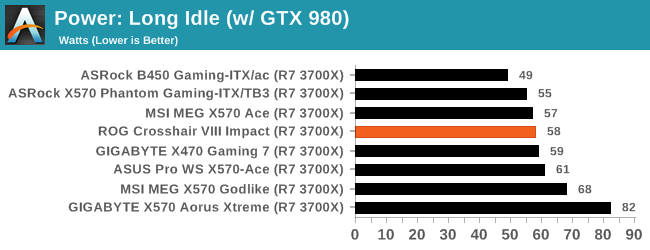
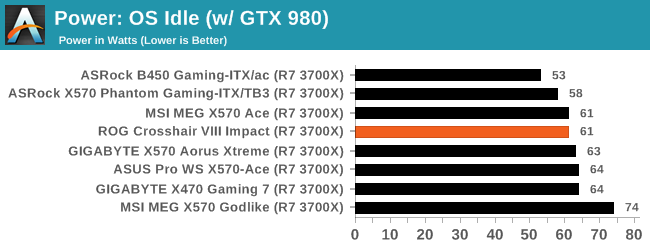
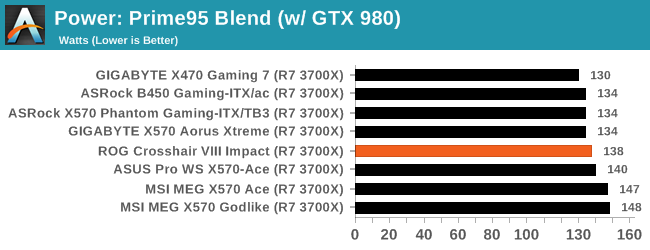
The ASUS ROG Crosshair VIII Impact performs very competitively against other X570 models on test with good results at long idle, and idle power states. At full load, the Impact also performs well, sitting in the middle of the pack.
Non-UEFI POST Time
Different motherboards have different POST sequences before an operating system is initialized. A lot of this is dependent on the board itself, and POST boot time is determined by the controllers on board (and the sequence of how those extras are organized). As part of our testing, we look at the POST Boot Time using a stopwatch. This is the time from pressing the ON button on the computer to when Windows starts loading. (We discount Windows loading as it is highly variable given Windows specific features.)
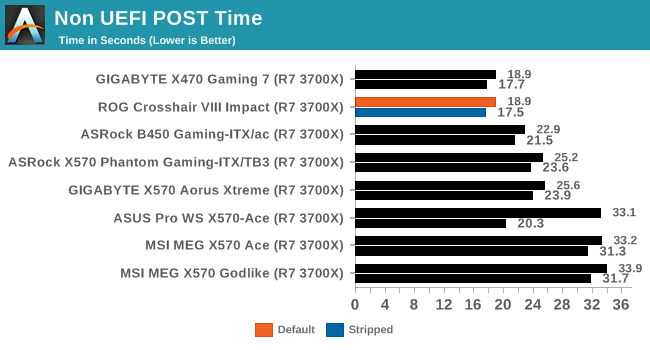
In our POST time test, the Crosshair VIII Impact has the best for POST times out of all the X570 models we have tested so far. At default, it managed to post the joint-fastest time with 18.9 seconds, and the fastest time with non-critical controllers disabled with a time of 17.5 seconds.
DPC Latency
Deferred Procedure Call latency is a way in which Windows handles interrupt servicing. In order to wait for a processor to acknowledge the request, the system will queue all interrupt requests by priority. Critical interrupts will be handled as soon as possible, whereas lesser priority requests such as audio will be further down the line. If the audio device requires data, it will have to wait until the request is processed before the buffer is filled.
If the device drivers of higher priority components in a system are poorly implemented, this can cause delays in request scheduling and process time. This can lead to an empty audio buffer and characteristic audible pauses, pops and clicks. The DPC latency checker measures how much time is taken processing DPCs from driver invocation. The lower the value will result in better audio transfer at smaller buffer sizes. Results are measured in microseconds.
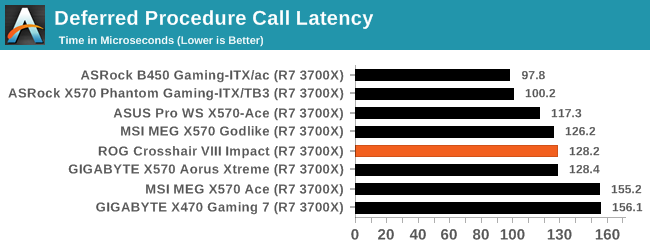
We test the DPC at the default settings straight from the box, and the ASUS ROG Crosshair VIII Impact did well with a latency time of 128.2 ms.
CPU Performance, Short Form
For our motherboard reviews, we use our short form testing method. These tests usually focus on if a motherboard is using MultiCore Turbo (the feature used to have maximum turbo on at all times, giving a frequency advantage), or if there are slight gains to be had from tweaking the firmware. We put the memory settings at the CPU manufacturers suggested frequency, making it very easy to see which motherboards have MCT enabled by default.
For X570 we are running using Windows 10 64-bit with the 1903 update as per our Ryzen 3000 CPU review.
Rendering - Blender 2.7b: 3D Creation Suite - link
A high profile rendering tool, Blender is open-source allowing for massive amounts of configurability, and is used by a number of high-profile animation studios worldwide. The organization recently released a Blender benchmark package, a couple of weeks after we had narrowed our Blender test for our new suite, however their test can take over an hour. For our results, we run one of the sub-tests in that suite through the command line - a standard ‘bmw27’ scene in CPU only mode, and measure the time to complete the render.
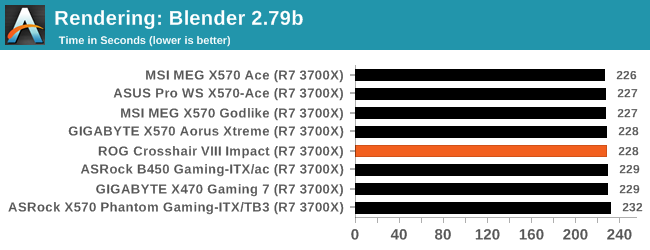
Streaming and Archival Video Transcoding - Handbrake 1.1.0
A popular open source tool, Handbrake is the anything-to-anything video conversion software that a number of people use as a reference point. The danger is always on version numbers and optimization, for example the latest versions of the software can take advantage of AVX-512 and OpenCL to accelerate certain types of transcoding and algorithms. The version we use here is a pure CPU play, with common transcoding variations.
We have split Handbrake up into several tests, using a Logitech C920 1080p60 native webcam recording (essentially a streamer recording), and convert them into two types of streaming formats and one for archival. The output settings used are:
- 720p60 at 6000 kbps constant bit rate, fast setting, high profile
- 1080p60 at 3500 kbps constant bit rate, faster setting, main profile
- 1080p60 HEVC at 3500 kbps variable bit rate, fast setting, main profile
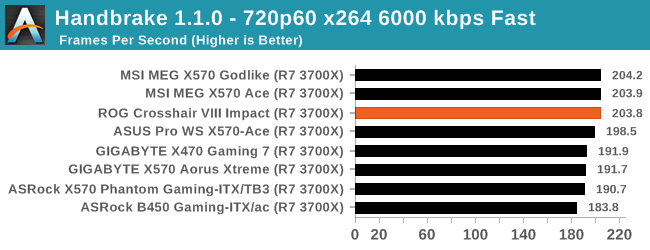
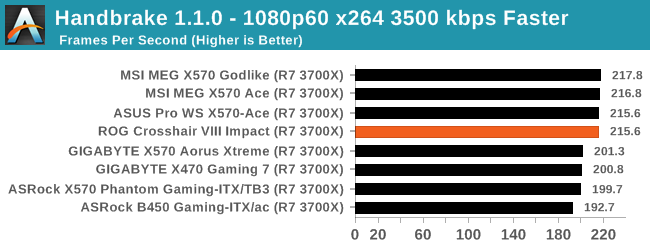
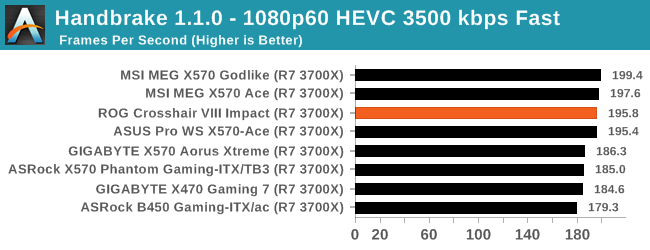
Rendering – POV-Ray 3.7.1: Ray Tracing - link
The Persistence of Vision Ray Tracer, or POV-Ray, is a freeware package for as the name suggests, ray tracing. It is a pure renderer, rather than modeling software, but the latest beta version contains a handy benchmark for stressing all processing threads on a platform. We have been using this test in motherboard reviews to test memory stability at various CPU speeds to good effect – if it passes the test, the IMC in the CPU is stable for a given CPU speed. As a CPU test, it runs for approximately 1-2 minutes on high-end platforms.
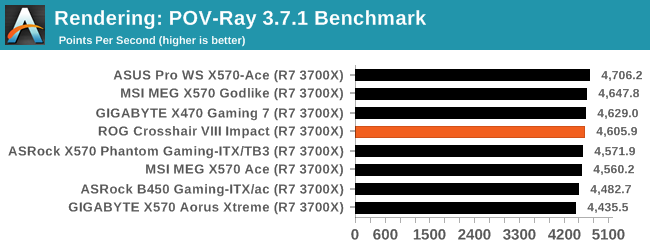
Compression – WinRAR 5.60b3: link
Our WinRAR test from 2013 is updated to the latest version of WinRAR at the start of 2014. We compress a set of 2867 files across 320 folders totaling 1.52 GB in size – 95% of these files are small typical website files, and the rest (90% of the size) are small 30-second 720p videos.
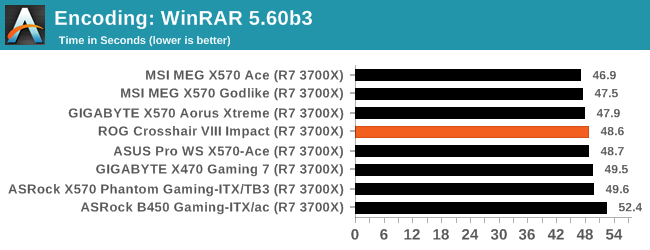
Synthetic – 7-Zip v1805: link
Out of our compression/decompression tool tests, 7-zip is the most requested and comes with a built-in benchmark. For our test suite, we’ve pulled the latest version of the software and we run the benchmark from the command line, reporting the compression, decompression, and a combined score.
It is noted in this benchmark that the latest multi-die processors have very bi-modal performance between compression and decompression, performing well in one and badly in the other. There are also discussions around how the Windows Scheduler is implementing every thread. As we get more results, it will be interesting to see how this plays out.
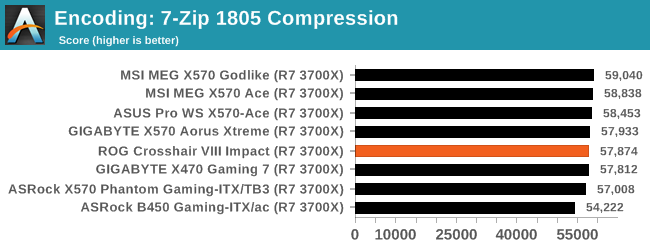
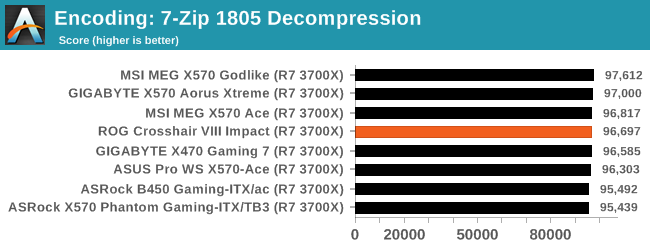
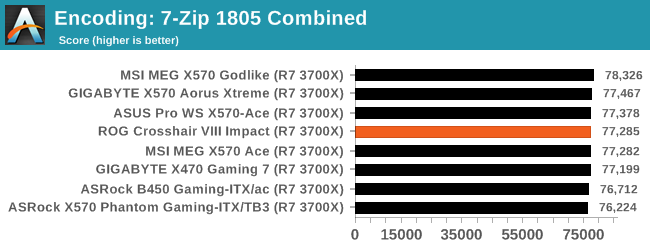
Point Calculations – 3D Movement Algorithm Test: link
3DPM is a self-penned benchmark, taking basic 3D movement algorithms used in Brownian Motion simulations and testing them for speed. High floating point performance, MHz, and IPC win in the single thread version, whereas the multithread version has to handle the threads and loves more cores. For a brief explanation of the platform agnostic coding behind this benchmark, see my forum post here.
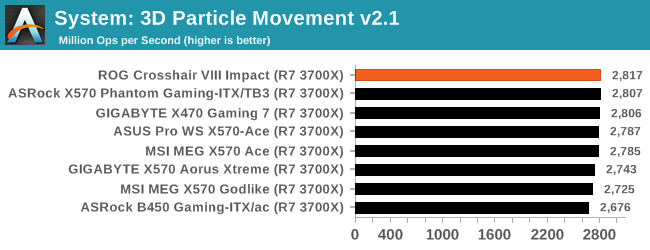
Neuron Simulation - DigiCortex v1.20: link
The newest benchmark in our suite is DigiCortex, a simulation of biologically plausible neural network circuits, and simulates activity of neurons and synapses. DigiCortex relies heavily on a mix of DRAM speed and computational throughput, indicating that systems which apply memory profiles properly should benefit and those that play fast and loose with overclocking settings might get some extra speed up. Results are taken during the steady-state period in a 32k neuron simulation and represented as a function of the ability to simulate in real time (1.000x equals real-time).
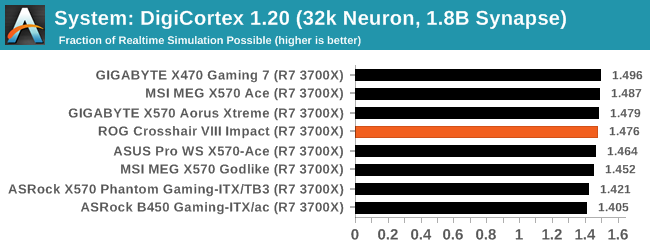
Gaming Performance
For X570 we are running using Windows 10 64-bit with the 1903 update as per our Ryzen 3000 CPU review.
World of Tanks enCore
Albeit different to most of the other commonly played MMO or massively multiplayer online games, World of Tanks is set in the mid-20th century and allows players to take control of a range of military based armored vehicles. World of Tanks (WoT) is developed and published by Wargaming who are based in Belarus, with the game’s soundtrack being primarily composed by Belarusian composer Sergey Khmelevsky. The game offers multiple entry points including a free-to-play element as well as allowing players to pay a fee to open up more features. One of the most interesting things about this tank based MMO is that it achieved eSports status when it debuted at the World Cyber Games back in 2012.
World of Tanks enCore is a demo application for a new and unreleased graphics engine penned by the Wargaming development team. Over time the new core engine will implemented into the full game upgrading the games visuals with key elements such as improved water, flora, shadows, lighting as well as other objects such as buildings. The World of Tanks enCore demo app not only offers up insight into the impending game engine changes, but allows users to check system performance to see if the new engine run optimally on their system.
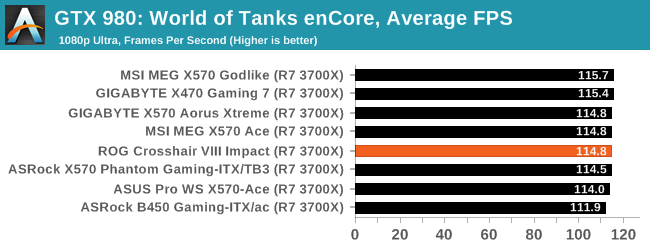
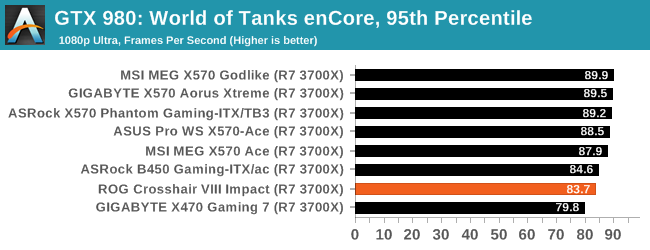
Grand Theft Auto V
The highly anticipated iteration of the Grand Theft Auto franchise hit the shelves on April 14th 2015, with both AMD and NVIDIA in tow to help optimize the title. GTA doesn’t provide graphical presets, but opens up the options to users and extends the boundaries by pushing even the hardest systems to the limit using Rockstar’s Advanced Game Engine under DirectX 11. Whether the user is flying high in the mountains with long draw distances or dealing with assorted trash in the city, when cranked up to maximum it creates stunning visuals but hard work for both the CPU and the GPU.
For our test we have scripted a version of the in-game benchmark. The in-game benchmark consists of five scenarios: four short panning shots with varying lighting and weather effects, and a fifth action sequence that lasts around 90 seconds. We use only the final part of the benchmark, which combines a flight scene in a jet followed by an inner city drive-by through several intersections followed by ramming a tanker that explodes, causing other cars to explode as well. This is a mix of distance rendering followed by a detailed near-rendering action sequence, and the title thankfully spits out frame time data.
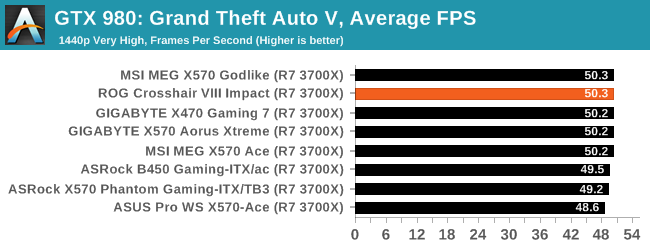
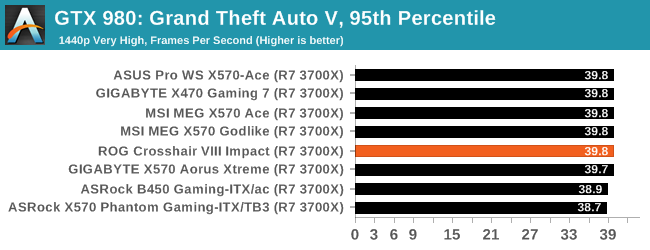
F1 2018
Aside from keeping up-to-date on the Formula One world, F1 2017 added HDR support, which F1 2018 has maintained; otherwise, we should see any newer versions of Codemasters' EGO engine find its way into F1. Graphically demanding in its own right, F1 2018 keeps a useful racing-type graphics workload in our benchmarks.
Aside from keeping up-to-date on the Formula One world, F1 2017 added HDR support, which F1 2018 has maintained. We use the in-game benchmark, set to run on the Montreal track in the wet, driving as Lewis Hamilton from last place on the grid. Data is taken over a one-lap race.
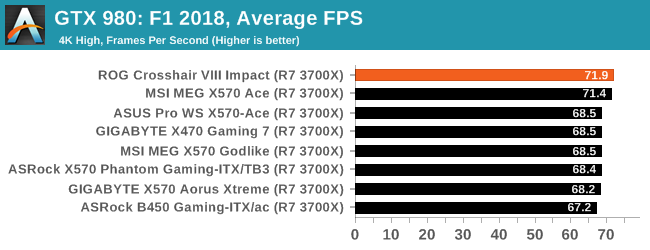
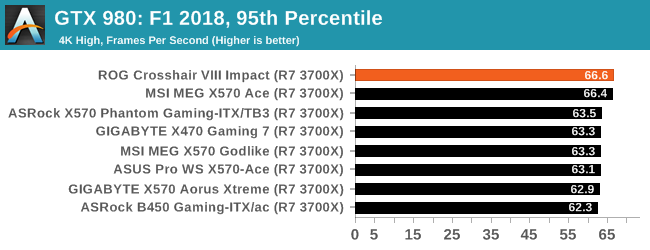
Overclocking Ryzen 3000
Experience with the ASUS ROG Crosshair VIII Impact
Overclocking with the ASUS ROG firmware on the ROG Crosshair VIII Impact is quite pleasant as all of the overclocking related options are located in the Extreme Tweaker menu. For most users looking to overclock the Ryzen 3000 processors, the primary settings to change are the CPU Core Frequency, CPU VCore voltage; memory overclocking can be done automatically by enabling the X.M.P memory profile which ASUS calls D.O.C.P. To make fine-tuned adjustments, ASUS includes plenty of voltage and SoC options, although the ROG Crosshair VIII Impact doesn't support the integrated graphics of the Ryzen APUs as there are no video outputs on the rear panel.
There are no CPU overclocking presets to select from, but users can enable one of the memory presets which are a good starting point for high-binned memory; not only is this expensive but due to the locked Infinity Fabric clock-speed, it becomes less effective without making FCLK adjustments beyond using DDR4-3600 memory. Users can use the firmware fine-tune the primary, secondary, and tertiary memory latencies in the DRAM Timing Control section.
Users looking to make performance-enhancing changes will need to rely on manually overclocking the processors. This is something ASUS ROG is very competent at providing with a whole host of customizable frequency, voltage, and power-related settings for users to chomp on. The firmware on the ASUS ROG Crosshair VIII Impact is well equipped for overclocking, it's very responsive to use and works well. For the more extreme overclockers, there is plenty to appreciate with lots of scope for LN2 cooling with its overclocker's toolkit, an LN2 specific mode, and lots of extreme memory profiles to use as a starting point.
Overclocking Methodology
Our standard overclocking methodology is as follows. We select the automatic overclock options and test for stability with POV-Ray and OCCT to simulate high-end workloads. These stability tests aim to catch any immediate causes for memory or CPU errors.
For manual overclocks, based on the information gathered from the previous testing, starts off at a nominal voltage and CPU multiplier, and the multiplier is increased until the stability tests are failed. The CPU voltage is increased gradually until the stability tests are passed, and the process repeated until the motherboard reduces the multiplier automatically (due to safety protocol) or the CPU temperature reaches a stupidly high level (105ºC+). Our testbed is not in a case, which should push overclocks higher with fresher (cooler) air.
Overclocking Results
The ASUS ROG Crosshair VIII Impact is very efficient with its VDroop at all of the tested frequencies with the firmware set to the auto LLC setting. From 3.6 GHz to 4.2 GHz with 1.250 V set on the CPU VCore in the firmware, we experienced around 0.038 V of VDroop compensation. This not only reduces the overall power consumption at maximum load, but it also helps to reduce CPU temperatures. Moving up to 4.3 GHz at 1.350 V on the CPU VCore, we saw a slight increase to this value at load with a CPU VCore of 1.356 V. We know our Ryzen 7 3700X processor is capable of running 4.3 GHz with slightly less load VCore, but it seems the firmware was playing it safe with a focus on overclocking stability. Our POV-Ray benchmark performance was consistent as we went up in each 100 MHz frequency stepping. The limit on our Ryzen 7 3700X with our testbed cooler is 4.3 GHz, and the Impact couldn't get our chip stable at 4.4 GHz regardless of the voltage we applied.
When it comes to Precision Boost Overdrive performance, and unlike in our review of the GIGABYTE X570 Aorus Xtreme review, the ASUS ROG Crosshair VIII Impact default performance leads us to believe that at default settings, some element of PBO is applied. The performance at default settings in our testing is the equivalent of our testing at 4.1 GHz, which shows the CPU is boosting higher at default settings than some vendors models. We did expect to see some CPU overclocking presets on this model, but this is something ASUS may add at a later date, but it seems the best way to achieve maximum performance is to manually overclock the processor.
Power Delivery Thermal Analysis
One of the most requested elements of our motherboard reviews revolves around the power delivery and its componentry. Aside from the quality of the components and its capability for overclocking to push out higher clock speeds which in turn improves performance, is the thermal capability of the cooling solutions implemented by manufacturers. While almost always fine for users running processors at default settings, the cooling capability of the VRMs isn't something that users should worry too much about, but for those looking to squeeze out extra performance from the CPU via overclocking, this puts extra pressure on the power delivery and in turn, generates extra heat. This is why more premium models often include heatsinks on its models with better cooling designs, heftier chunks of metal, and in some cases, even with water blocks such as the ASUS ROG Crosshair VIII Formula.
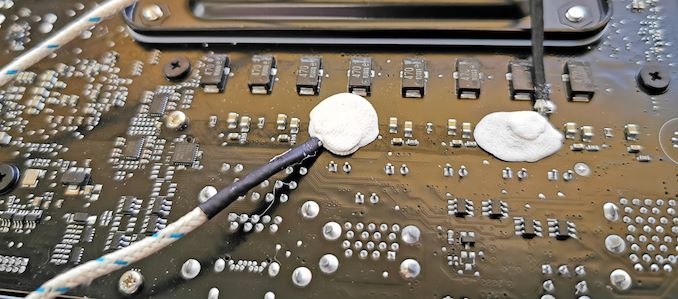
Two K-Type Thermal Probes attached to the rear of the power delivery on the ASUS ROG Crosshair VIII Impact
Testing Methodology
Out method of testing out if the power delivery and its heatsink are effective at dissipating heat, is by running an intensely heavy CPU workload for a prolonged method of time. We apply an overclock which is deemed safe and at the maximum that the silicon on our AMD Ryzen 7 3700X processor allows. We then run the Prime95 with AVX2 enabled under a torture test for an hour at the maximum stable overclock we can which puts insane pressure on the processor. We collect our data via three different methods which include the following:
- Taking a thermal image from a birds-eye view after an hour with a Flir Pro thermal imaging camera
- Securing two probes on to the rear of the PCB, right underneath CPU VCore section of the power delivery for better parity in case a probe reports a faulty reading
- Taking a reading of the VRM temperature from the sensor reading within the HWInfo monitoring application
The reason for using three different methods is that some sensors can read inaccurate temperatures, which can give very erratic results for users looking to gauge whether an overclock is too much pressure for the power delivery handle. With using a probe on the rear, it can also show the efficiency of the power stages and heatsinks as a wide margin between the probe and sensor temperature can show that the heatsink is dissipating heat and that the design is working, or that the internal sensor is massively wrong. To ensure our probe was accurate before testing, I binned 10 and selected the most accurate (within 1c of the actual temperature) for better parity in our testing.
For thermal image, we use a Flir One camera as it gives a good indication of where the heat is generated around the socket area, as some designs use different configurations and an evenly spread power delivery with good components will usually generate less heat. Manufacturers who use inefficient heatsinks and cheap out on power delivery components should run hotter than those who have invested. Of course, a $700 flagship motherboard is likely to outperform a cheaper $100 model under the same testing conditions, but it is still worth testing to see which vendors are doing things correctly.
Thermal Analysis Results
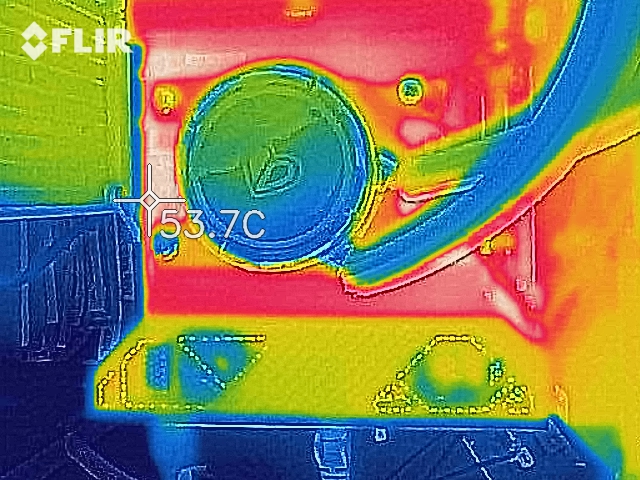
We measured 53.7°C on the hottest part of the board during our testing, the PCB around the VRMs
The ASUS ROG Crosshair VIII Impact is using a 10-phase power delivery with eight Infineon TDA21472 70 A power stages and two TDA21472 70 A power stages for the SoC which are mounted onto the rear of the PCB. The PWM controller of choice is the ASP1405I running in a 4+2 configuration but without doublers. Cooling on the power delivery is expansive with an actively cooled heatsink that has a 30 mm fan integrated into the rear panel cover, and also included a backplate on the rear which incorporates a slim heat pipe into its design. For a small form factor model, this is pretty comprehensive as both the front-mounted CPU section and rear-mounted SoC power stages all have some form of thermal reducing properties to maximise performance.
The results from our power delivery thermal testing put the ASUS ROG Crosshair VIII Impact in good stead for overclockers looking to use this board for high-performance systems. When directly compared to the other small form factor X570 model we've tested, the ASRock X570 Phantom Gaming-ITX/TB3, the Impact power delivery runs around 8°C cooler when comparing the integrated VRM temperature sensors. The performance can be attributed to the small 30 mm cooling fan over the top of the power delivery heatsink, as well as the backplate with a heat pipe integrated negating heat from the front and back. Our external probe reading does seem a little low with a reading of 49°C when compared with previous models on test, but the more heat the heatsinks can remove, the lower the probe temperature should be. The power delivery cooling solution makes the ROG Crosshair VIII Impact the most equipped small form factor board we've seen so far for overclocking Ryzen's 3000 series of processors, and with its high $430 price tag, we wouldn't expect anything less than best-in-class performance; the ASUS ROG Crosshair VIII Impact, in this instance, is certainly that.
Deep Impact
The ASUS ROG Crosshair VIII Impact costs $430. There's no getting away from it - this is by far the most expensive small form factor motherboard at present on the X570 chipset. There ASUS ROG Crosshair VIII Impact also throws up an interesting question for SFF systems, with its slightly larger mini-DTX form factor. The Impact is effectively in a class of its own at the price point and with the unique DTX form factor. That being said, while the primary target market of the Impact is enthusiasts looking to build a smaller form factor, the truth is that the mini-DTX size does cancel out any mini-ITX chassis designs, causing the user to look at micro-ATX cases.
Its core feature set comes also comes from its use of the SO-DIMM.2 slot which allows users to add two PCIe 4.0 x4 M.2 drives in with both NVMe and SATA support included. Outside of this is four SATA slots, with two straight-angled, and two right-angled ports with RAID 0, 1, and 10 support out of the box. The provided networking support of Intel's I211-AT Gigabit Ethernet controller raises questions as to why a model costing $430 is still reliant on a single gigabit Ethernet port, but the inclusion of an Intel AX200 Wi-Fi 6 wireless interface which adds BT 5.0 connectivity does offer some credence to the price tag.
Another interesting feature is how the SupremeFX S1220 HD audio codec and assisting ESS ES9023P DAC has been implemented to save even more space on the ROG Crosshair VIII Impact; through an M.2 B-key slot located just below the full-length PCIe 4.0 x16 slot. The S1220 HD codec itself comes with EMI shielding and plenty of gold Japanese audio capacitors, and as from most onboard audio solutions, is well isolated from the rest of the board's componentry. This is covered by a ROG themed black metal fascia which fits in with the rest of the Impact's neutrally black color scheme.
The overall design of the ROG Crosshair VIII Impact is clean, concise and for what it has in integrated RGB along the right-hand side of the board, it looks good and not overpowering. Users can expand on this with two ARGB connectors, one on the PCB itself and one on the SO-DIMM.2 add-on card. The SO-DIMM.2 also adds two 4-pin fan headers in addition to the three 4-pin headers located on the board; one for a CPU fan, one for a water pump, and another designated as a chassis fan header. This further adds to the Impact as both a premium model and one that's suitable for water cooling.
Looking at connectivity, on the rear panel is plenty of USB support which consists of five USB 3.1 G2 Type-A, one USB 3.1 G2 Type-C, and two USB 3.1 G1 Type-A ports. Unlike most conventional models, ASUS includes its LED Debugger on the rear panel and for good measure, also include a reset switch, a clear CMOS button, and a USB BIOS Flashback button. There are just three 3.5 mm audio jacks on the rear panel so users looking to use surround sound or speaker setups with more than three outputs will need to use the front panel audio header also featured on the M.2 B-key audio card; there's also a single S/PDIF optical output. The ASUS ROG Crosshair VIII Impact doesn't feature any video outputs but for a model to this standard and caliber, it would be expected that users will use a discrete graphics card.
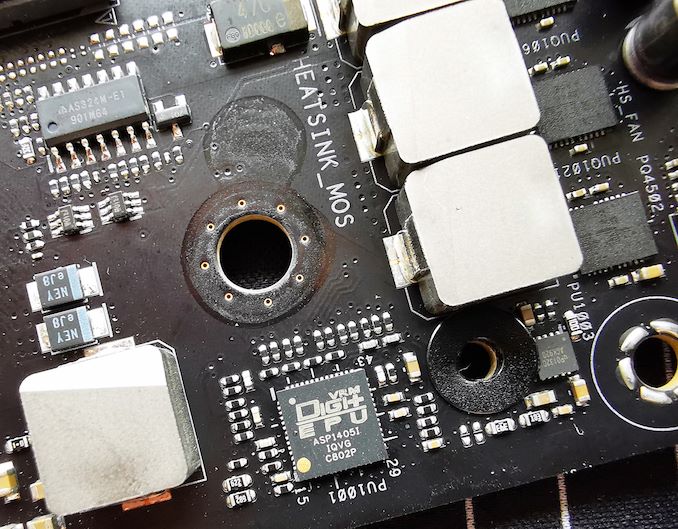
The ASP1405I 8-phase PWM controller on the ASUS ROG Crosshair VIII Impact
The ASUS ROG Crosshair VIII Impact also performs very competitively with other X570 models on testing, with fast non-UEFI POST times, consistent power consumption and good computational performance. Couple that in with the impressive power delivery thermal performance which is underpinned by the 30 mm cooling fan directly over the heatsink is something all premium models should consider implementing. ASUS takes this further with a backplate that has a heatpipe in which is useful as the 2-phase SoC section is mounted on the rear of the board. The 8-phase CPU power delivery is teamed and performs very well in our overclocking testing with good VDroop for better efficiency, and has plenty of support for overclockers looking to take Ryzen 3000 under more extreme cooling methods such as LN2 with its own LN2 mode. At default settings, ASUS is known for its solid out of the box optimizations, but for overclocking, the Impact is the Dirty Harry of the small form factor X570 offerings.
It's hard to compare a $430 model such as the ASUS ROG Crosshair VIII Impact to other models which it dwarves in price. The next best model in terms of size is the ASRock X570 Phantom Gaming-ITX/TB3 ($240) which is mini-ITX and has Thunderbolt 3 support. While the ASUS ROG Crosshair VIII Impact is a solid board and looks to provide a very rigid platform to build on, the price really does take it out of the market for all but the extreme systems.

